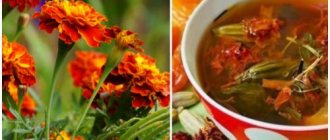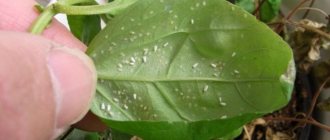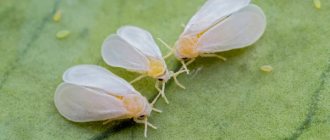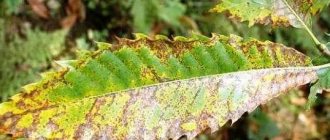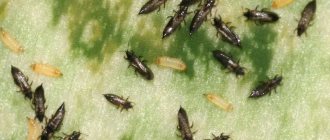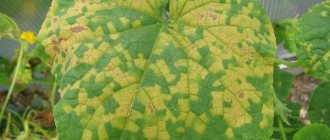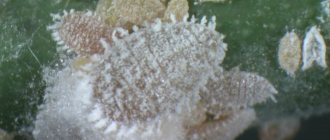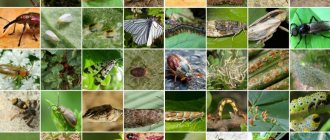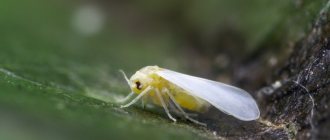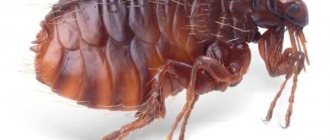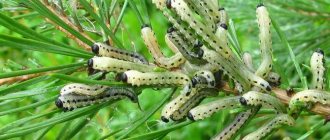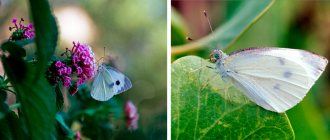All plants, no matter where they are grown, are subject to invasion by various pests. In addition, indoor plants that housewives love to grow are susceptible to various diseases and the harmful effects of various insects. Various reasons contribute to this. Often housewives themselves are to blame for this, since they do not create the proper conditions for growth and development for plants. Some of them simply forget to water the plants, and some of them water them excessively. It should be noted that there are quite dangerous pests that can reduce a person’s work to zero.
As a result of the appearance of pests, indoor plants lag behind in development and lose their attractiveness, and often even die. Therefore, the main task of indoor plant lovers is the timely detection of parasites and subsequent control of them. This article talks about the main pests of indoor plants, their appearance, as well as ways to combat them.
Whitefly
This is an insect with a body length of no more than 2 mm. A characteristic feature is white wings and a yellowish body. They can be found:
- On the back side of the leaves, where they are located in colonies.
- According to characteristic sweetish traces, on which after some time a sooty fungus appears.
Whitefly larvae have a sucking type of mouthparts, so they suck out the juices from the plant. As a result, the plant loses its vitality and gradually loses its attractiveness. If no measures are taken, the plant will soon die.
Interesting fact! When appearing in greenhouses, the whitefly prefers plants such as hibiscus, pelargonium or begonia. After the appearance of just one individual, after a short period of time a whole colony of these insatiable pests appears in the greenhouse. In this regard, the fight should begin immediately.
Saving indoor plants from pests and diseases - Everything will be fine - Issue 282 - 11/05/2013
Signs of pests
What needs to be done to save pets? First of all, find out what harmful insects have infested the flowers. To do this, a thorough examination of the plant itself and the soil is carried out. After this, they begin a merciless fight using various methods. Remember, any delay is fraught with disastrous consequences.
Insects live in the soil (on roots), on leaves, stems, and gnaw buds.
Plants react to each pest in a special way: they can change the color of leaves and slow down their growth. When visually examining a houseplant, you can notice changes in the leaves and stems.
White spots
White spots are a signal of the appearance of:
- Mealybug or rootbug. You need to examine all parts of the flower. If you notice “cotton” lumps, it means there is a pest.
- When whiteflies appear, the leaves become sticky and may fall off.
- The presence of a red spider (clover) mite can be determined by the whitish mesh, spider mite by the cobweb. Leaves with a large number of insects die off.
Yellow spots
If yellow spots appear on the leaves, you need to inspect the leaves. If fingers stick to them, these are marks left by scale insects. The cause may be the appearance of enchytraea. Tiny white worms live in the soil right at the root.
If you notice the presence of brown, brownish spots on the bottom of the leaf and white smudges on top, this indicates the action of thrips.
Deformation of foliage and stems
If the shoots and leaves on the flowers begin to deform, it means that the flower is affected by aphids or cyclamen mites. Aphids leave behind sticky residues. It sucks the juice from indoor plants, which can cause them to dry out. If dust appears on the leaves below, they curl—the mite is in charge.
The cause of drooping leaves and shoots is fungus gnats, leaf or root-knot nematodes.
Aphid
These are also harmful insects that suck juices from plants due to the presence of piercing-sucking mouthparts. Insects have an ovoid body shape, no more than 2 mm in length. Aphids have rather long legs, but they move rather slowly. The color of insects depends on the species, as well as on living conditions, so it can be varied.
There are both winged and wingless types of insects. Naturally, insects with wings can easily enter a person’s home, even through an open window.
Hairy aphid
This type of aphid is also called mealybugs. They are one of the most dangerous insects for plants. As a rule, they can be found on the underside of leaves. Their presence is indicated by a cobweb-like white coating, as well as the presence of a sticky liquid.
These insects are distinguished by a high degree of fertility. Female mealybugs lay eggs in miniature formations that resemble balls of cotton wool. After a certain time, fairly mobile larvae emerge from these lumps, which are then distributed throughout the plant. Fighting them requires an instant reaction. The sooner you start fighting this pest, the greater the chance of saving the plant.
Mealybug is a pest of domestic flowers. Signs of infection, methods of control
Root mealybug
This type of pest poses the main threat to the root system of plants. The parasite can be detected either in the ground or on the lower part of the plant stems, by a whitish coating. Females reach a length of up to 2.5 mm, while they are larger than males and much more mobile. Pests are distinguished by their almost cylindrical body shape, covered with a waxy coating. Females lay eggs in special chambers formed by special secretions.
Males are more like whiteflies. As adults, they quickly die because they stop feeding. Therefore, females make up the main population of these pest colonies.
It is important to know! The presence of such insects on indoor plants leads to the fact that the plants lose their attractive appearance. In addition, damaged plants begin to suffer from fungal diseases.
Prevention to protect indoor plants from diseases and pests
Improper care and mistakes when choosing a location can greatly weaken the plants. In such cases, flowers easily become victims of diseases and pests. Therefore, the best protection for indoor plants from pests and diseases is prevention and the correct choice of location.
If it was not possible to avoid the disease or pests, then quick diagnosis and targeted treatment will help.
Proper care is considered guaranteed protection against diseases and pests.
How to carry out preventive measures to protect indoor plants from diseases and pests:
- It is especially important to increase air humidity during the heating season. Dry air is the main cause of pests.
- Avoid plant density that is too high.
- Trim dead leaves and flowers regularly and keep pots and soil clean.
- Plant tissues can be strengthened through the correct dosage of fertilizers and using special products such as horsetail mixtures containing silicic acid or aromatic sprays.
There are quite a few pests on indoor plants. Most often they are very small and not always immediately noticeable. They live and reproduce both in the soil and on parts of the plant itself. If pests of indoor plants appear and measures are not taken against them, then the flowers begin to wither, turn yellow, and then die altogether.
Shchitovka
Scale insects also appear on house plants, and each type of scale insect can infect a specific type of plant. The palm scale insect parasitizes the shoots of palm trees. There are also cactus, pink, ivy, Californian, laurel, and oleander scale insects. Often scale insects appear on lemons or orchids. A characteristic feature of these pests is the shell that protects their body. In this regard, it is quite difficult to fight scale insects.
The false scale insect, which does not have a waxy shell, poses a huge danger to plants. The females of these pests grow up to 5 mm in length, and they have neither legs nor wings, unlike males. Females are distinguished by the fact that their body is covered with a convex shield, which can have different shapes, both round and oval.
These parasites prefer to be found on any part of the plant, both on the stems and on the back of the leaves. There is also a hemispherical scale insect, which is slightly larger in size and volume. Plants such as ferns, asparagus and myrtle are affected by these pests. Below is the appearance of some pests of indoor plants.
Fighting scale insects (pests of indoor plants). Part 1
Small, elongated, black bugs appeared on the flowers. Tell me how to process it??
Thrips reproduce very quickly - at optimal temperatures for them (and for many species this is just room temperature - 20-25°C) they can double their numbers in 4-6 days.
If thrips are found on plants, it is necessary to inspect nearby plants, since thrips easily move to neighboring plants.
If possible, it is better to isolate affected plants from healthy ones. Transfer the plants very carefully: when the transferred plants are shaken, the larvae and adults easily fall from the leaves and can wait a long time to settle on the plants again.
The place where the thrips-affected plants stood should be thoroughly cleaned, and the topmost layer of soil mixture in pots from treated plants should also be removed.
Before treating with insecticide, wash the plant in the shower. If you don’t have an insecticide at the moment, you can wash the plant with a sponge and laundry soap; this is a temporary measure and does not eliminate thrips!
The following drugs can be used:
Fitoverm dissolve 2 ml in 200 ml of water. Spray the affected plant with the resulting solution, after spraying, put a transparent plastic bag on the plant; the bag can be removed after a day.
Dissolve Vertimek 2.5 ml of the drug in 10 liters of water. Spray the affected plant with the resulting solution, after spraying, put a transparent plastic bag on the plant; the bag can be removed after a day.
Agravertine consumption rate: 5 ml per 0.5 l of water. At temperatures below +18 degrees it penetrates poorly into plant tissue. Spray the affected plant with the resulting solution, after spraying, put a transparent plastic bag on the plant; the bag can be removed after a day.
Aktelik dissolve the ampoule in 1 liter of water (has a very pungent odor). Spray the affected plant with the resulting solution, after spraying, put a transparent plastic bag on the plant; the bag can be removed after a day.
Karate consumption rate: 0.5 ml per 2.5 liters of water (2 ml ampoule).
Confidor should not be sprayed with the solution, but rather the substrate should be spilled from the infected plant.
Karbofos consumption rate: 15 g per 2 liters. water (packages of 60 and 30 g).
Intavir consumption rate: dissolve 1 tablet in 10 l. water. Spray the affected plant with the resulting solution, after spraying, put a transparent plastic bag on the plant; the bag can be removed after a day.
The treatment must be done at least twice with an interval of 7-10 days, since larvae gradually hatch from the eggs laid in the leaf tissue. Folk remedies.
Various folk remedies help with minor plant infestation by thrips, but if the infestation is widespread, then it is necessary to use various systemic insecticides that penetrate the plant and act through the plant tissue on thrips.
White fool
White podurs are hopping insects that can be found in potted houseplants. They differ:
- An elongated body on which sparse hairs grow.
- Having 3 pairs of legs.
- Having a long mustache.
- Prefers moist conditions.
The diet of these pests includes the remains of plant components, as well as a living root system. If you do not pay attention to these parasites in time and do not destroy them, they can lead to the death of indoor plants.
Spider mite
Many indoor plant lovers are familiar with this common and quite dangerous pest. This is a tiny insect that can only be detected with a magnifying glass. Colonies of these insects are found on the underside of leaves. Spider mites prefer warm and dry air. Under such conditions, the insect reproduces at a tremendous rate.
You can determine that a plant is infected with spider mites:
- By light spots that are visible in places where pests live.
- By the presence of the finest cobwebs that cover plants.
Chinese roses, geraniums and palm trees suffer quite a lot from the invasion of spider mites, which suck the juices out of them.
How to get rid of pests of indoor plants: methods of protecting flowers
There are several ways to deal with pests of indoor plants. Some of the most effective are mechanical protection, biotechnical methods and the use of chemicals.
How to get rid of pests on indoor plants using mechanical protection:
- Remove affected parts of the plant.
- Carry out pest removal, including washing them off in the shower.
- Immerse the above-ground parts of the affected plant in warm water with a small amount of detergent. The pot must first be placed in a plastic bag and tied at the top.
Biological control methods involve the use of beneficial insects, for example:
- Riders against whiteflies,
- Predatory mites against spider mites and fringed mites,
- Predatory gall midges, goldeneyes or parasites against aphids.
Beneficial insects are the most effective treatment when a large number of plants are affected and the air is not too warm and dry. The ideal temperature is considered to be about 20 °C, but at 27 °C and above, success is questionable.
Biotechnical control methods use natural responses of pests to physical or chemical irritations:
- Yellow plates are insect traps coated with glue that attract leafminers, whiteflies, sciarids and other flying pests with their bright color.
- In a “plant bath”, spider mites are destroyed due to the very high air humidity. To do this, water the plant well and place it in a transparent plastic bag. Be careful, rot! Plants with soft leaves do not tolerate this treatment.
- Oily products, such as white oil, clog the insects' airways. Leaf shine sprays work in a similar way.
Don't jump straight into pesticides. In many cases, the same effect can be achieved using completely harmless means.
Chemicals should only be used as a last resort. If you have to use chemicals, you must follow the following rules:
- Follow the directions for use and dosage contained on the package.
- Maintain recommended intervals between treatments to eliminate new generations of pests.
- Do not use sprays that are harmful to the environment.
- Treat plants only outdoors.
- Wear gloves and do not inhale spray products.
- Store plant protection products in closed original packaging out of the reach of children and pets.
- Do not store leftover chemicals; their effectiveness is quickly lost. Do not throw chemicals away with regular household waste, but take them to a special waste collection point.
These photos show how to deal with pests of indoor plants using various methods:
Thrips
These are insects whose length does not exceed 1.5 mm. Pests can be identified by their black or dark brown body color, with the lower part of the body being a reddish-yellow hue. Like most pests, thrips hide on the underside of leaves. The female lays eggs in very small holes, which she gnaws in the leaves and also in flower buds.
It is important to know! The appearance of a silver pattern on indoor plants indicates that the plants are infected with thrips. These are traces of their life activity.
TRIPS on indoor flowers | PESTS of indoor plants and their control
Codling moths, moths, copperheads, sawflies, small caterpillars
Preventive spraying is carried out during the flowering period, during the summer of butterflies: every 5 days.
Sagebrush
Steam a kilogram of bitter herb with a bucket of boiling water. After cooling, strain.
Red hot pepper
Prepare an infusion from 1 kg of fruit and 10 liters of water, strain, and put in a cool, dark place. To spray, dilute 500 ml of liquid with ten liters of water.
Onion
Chop 100 g of onion, add 1 liter of cold water, leave without boiling for 24 hours.
Fungus gnats (sciarids)
These insects are also called scyriads. These are not large flies, up to half a centimeter long, that fly around indoor plants. Sexually mature individuals carry the larvae of various pests, which infect plants. The scyriads themselves lay eggs in the root system of plants, which causes great harm to the plants, since white larvae emerge from the eggs and feed on the root system. The result of their vital activity is dead indoor plants.
Control measures
How to get rid of pests? This question haunts many indoor plant lovers. Pest control can be done in a variety of ways. For example:
- Mechanical.
- With the help of biological drugs.
- Using chemical control agents.
- Based on folk recipes.
Pests of indoor plants and their control, plant protection, how to get rid of them
Mechanical method
This is an environmentally friendly, simple and affordable way to combat parasites on your own. To do this, you need to take a tool, preferably disinfected, and cut off the damaged parts of the plants. It is better to treat the cut areas with activated carbon. Pests that can be seen with the naked eye can be picked out with your hands without any problems, unless there are so many plants and pests.
Interesting recipe! A contrast shower will help rid indoor plants of parasites. It is enough to spray the flower with water and then wipe the leaves with a cotton swab and the problem can be solved.
Folk remedies
To protect them from various insects, as well as in cases of their diseases, many lovers of indoor plants prefer folk remedies. These products have been tested for many decades, so there is no doubt about their effectiveness. Decoctions prepared from plants such as chamomile, nettle, yarrow, dandelion or marigold are absolutely harmless to humans and plants. Solutions prepared with garlic and onions have the same effect. The prepared solutions are simply sprayed on the plants almost every day.
As an option, you can use citrus peels, which should simply be buried in the ground. The smell of these components cannot be tolerated by many parasites that want to settle on indoor plants.
Solutions based on wood ash, furatsillin, soda or potassium permanganate work no less effectively in this direction. You just need to prepare the solution correctly, after which the plants are sprayed with a spray bottle.
It is important to know! If you add a little soap, preferably laundry soap, to the solutions, the product will not drain from the leaves so quickly, which will enhance the effect of using the product.
Biological method
Biological preparations differ in that they act only on certain types of pests and are safe for humans and pets. Despite this, the working composition must be prepared correctly and used correctly. For example:
- The solution is prepared strictly according to the instructions.
- After treatment, the plant should dry.
- The room needs to be well ventilated.
For such purposes, you can use control agents such as Agrovertin, Fitoverm or Iskra-Bio.
Slugs
These quickly multiplying and very active pests usually don’t care whether they chew seedlings or adult plants, although, of course, they prefer the tender pulp of young sprouts.
You will see irregularly shaped holes, and even traces of mucus - harm is certain.
During the day, naked slugs hide in shelters in damp places (high air temperatures and direct sunlight are destructive for them), and at night they “feast” on young greenery.
The main measure to combat slugs is to collect them daily by hand or install traps with a taste bait, where they crawl en masse.
If there are a lot of shellfish, first you can try preparations based on iron phosphate (Ferramol, Ulicide, etc.) and flavor bait. Granules should be scattered over the soil surface in places where pests accumulate. The active ingredient of such products is safe for humans and animals and over time decomposes in the soil by microorganisms, but poisons slugs.
More effective, but also unsafe means are molluscicide preparations (Slug Eater, Groza-3, Predator, StopUlit) based on metaldehyde or copper compounds. Unfortunately, these products are also quite poisonous to humans, birds and animals (hazard class 2-3), so they must be used with great care and with all precautions.
If you are a supporter of exclusively environmental methods, look for nature-safe biological products based on parasitic nematodes.
To prevent slugs on the site, it is important to follow agricultural practices and maintain order - do not forget to thicken the plantings, follow the watering schedule, mow the grass on time, remove plant residues and debris, and plow the soil deeply.
- How to deal with slugs on the site: folk remedies and chemicals
Spring has arrived, which means numerous pests are awakening. Some of the most unpleasant are slugs, which can destroy almost all plantings.
